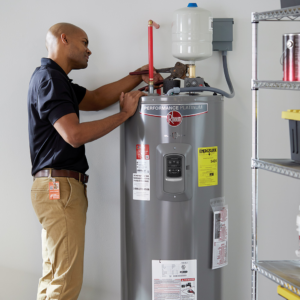Water Heater is an appliance that warms water to the point where it can be used in your showers, washing machines and dishwasher. Water heaters can be gas or electric.
Tank-type water heaters have large insulated tanks that hold hot water until needed. Cold water enters the bottom of the tank, then heat is provided by either a gas flame below the tank or electric heating elements suspended inside the tank.

Water heating is the second largest energy expense in homes, after home heating and cooling. Fortunately, it’s also one of the easiest places to save energy and money. From lowering your water heater temperature to installing a smart water heater, there are many ways to reduce water heating costs. These strategies not only help the environment and contribute to a sustainable future, they also save you hundreds of dollars per year.
The ENERGY STAR® label is a trusted indicator of an energy efficient water heater, with new models meeting higher efficiency standards than ever before. These new energy efficiency standards—referred to as UEF—account for the majority of the potential savings from upgrading a water heater.
In addition to the new UEF standards, some local utility companies have added incentives and rebates for smart grid-interactive water heaters. These models provide a variety of benefits including load shifting, demand response and automated efficiency optimization. Combined with smart meters and a home energy management system (HEMS), they can offer key grid, energy and climate benefits such as increased interconnectivity, control, flexibility and resilience for the grid.
Another way to save energy and money is to fix leaks quickly. A leaking hot water faucet may seem like a minor issue, but it can waste a lot of energy over time by continuously heating additional water. Additionally, fixing a leaking gas line or hose can prevent costly and dangerous accidents at home.
Finally, consider switching to a heat pump electric water heater (HPWH) for your home. These models use the same technology used in air conditioning and refrigeration to generate hot water at a fraction of the energy cost. HPWHs are also more environmentally friendly than traditional storage tank electric models, especially when used in combination with district heating using low carbon electricity.
In fact, using HPWHs in conjunction with solar PV systems is a great solution for households with high solar usage and lower than average household electricity consumption. This combination can help offset the upfront capital investment and significantly lower energy and carbon emissions in a home.
Installation
A water heater keeps your home hot so you can wash clothes, cook, shower and take a bath. When yours breaks, you’ll need a replacement fast to avoid a costly flooded basement and possible water damage repair costs. A professional can ensure the new model connects to your existing gas and plumbing lines safely and in accordance with local codes and regulations.
A storage tank water heater is the most common type, with an insulated tank that holds the hot water until you turn on a faucet or appliance. They are available in electric and gas models. You can upgrade to a high efficiency model that will save money and space.
You can replace a storage tank with a tankless model, which is more efficient and will reduce energy consumption in your home. However, it will require an upgrade of your piping system and installation of a new electrical circuit to handle the higher current load.
Most newer water heaters are made of steel, and you can choose from an electric or a gas-powered model. They both have advantages and drawbacks, so consult a pro to determine which is best for your home.
Many states and cities require that you have a venting system to carry the exhaust gas away from the water heater. This is to prevent the hot water heater from polluting indoor air with dangerous carbon monoxide. If you have an old or damaged venting system, code may require a change.
You should also consider the location of your new water heater. It should be placed in a well-ventilated area and not in an unfinished or cluttered room. It should be easily accessible for maintenance and repair. It should be in a location where the water supply and drain lines will not interfere with furniture or appliances.
A water heater is heavy, so you’ll need a couple of strong people and an appliance dolly to lift it into place. If you’re moving it to a different location, your contractor will need to block holes in the walls and install studs to support the brackets and the weight of the unit.
Maintenance
Water heaters are powerful appliances with complicated parts that combine electricity, hot water and sometimes gas. For this reason, they require specialized knowledge to perform maintenance or repairs. The right professional will help ensure your hot water heater continues to function efficiently while saving you energy.
Inspecting and cleaning a water heater should be done regularly to prolong its life. This can include flushing the tank once a year, checking the temperature setting to be sure it is safe for your home and preventing bacteria from building up in the unit.
The hot water pipes that connect to your hot water heater should also be insulated to reduce heat loss and improve efficiency. You can do this by measuring the hot water pipes and cutting lengths of pipe insulation to wrap around them. If you are concerned about how to insulate your hot water system, consider hiring a plumbing professional for installation.
Performing regular maintenance on your water heater will extend its lifespan and prevent costly repairs. Most units are designed to last between eight and 12 years, depending on the make and model. While there are some things that you can do on your own, it is important to have an annual inspection by a qualified professional.
A professional plumber will inspect your unit for safety, proper operation and a range of other factors that can affect performance. They can clean your tank, flush the unit and replace the anode rod if necessary. Additionally, they can recommend the best water heater temperature settings to balance comfort and energy savings.
The most common signs that your water heater is deteriorating include clinking noises from the inside of the tank during operation, the inability to take a hot shower and the pilot light constantly going out. Other signs you need a repair are more severe leaks from the unit itself and issues with your pressure relief valve.
Because these appliances mix power, water and gases, they can be dangerous to work on without the proper training and tools. You should always follow the manufacturer’s recommendations for maintenance, and if you are uncomfortable working with them yourself, call in a professional. A facility management software solution like ServiceChannel can help you schedule and track maintenance on your water heater and all other equipment, including air conditioning.
Replacement
If your water heater is nearing the end of its lifespan or you’re planning a new construction project, consider going with a high-efficiency model. New storage tank models meet federal energy efficiency standards, and tankless (on-demand) water heaters are even more efficient. They also require less maintenance.
When you’re ready to replace your old water heater, keep in mind that the cost of a new unit can vary widely depending on the type and size. For example, a new gas or electric model will likely be cheaper than an upgrade to a hybrid water heater that uses both solar energy and natural gas.
If you choose a gas water heater, consider a condensing model that operates at a higher level of efficiency by capturing hot exhaust gases and re-using them to heat the water in your home. The lower operating costs and improved efficiency can make this a great choice for many households.
You’ll also want to factor in the first-hour rating, or FHR, which indicates how much hot water a model can produce in an hour beginning with a full tank. This can help you determine if a larger or smaller tank is appropriate for your household’s needs.
In addition, check that the model you’re considering can be installed in your home’s existing space. You don’t want to waste money on a new water heater that’s too large for your space.
Finally, don’t forget about possible energy rebates and financing options for the new water heater. These programs can help you save money on your energy bills and protect the environment by reducing carbon dioxide emissions.
If you decide to install a new water heater, make sure your contractor removes and disposes of your old one properly. Then, take steps to prevent wasting energy by insulating your hot and cold water pipes and installing a programmable thermostat or smart water heater controller.
CityWide Sewer & Drain can safely and responsibly remove your old water heater, dispose of it according to proper guidelines, and install the right unit for your home or business. Contact us today for more information about our water heater installation services in the New York area.
